Learn the intriguing differences between Carpenter Bees and Mud Daubers that will leave you fascinated and better prepared for any unexpected insect visitors.
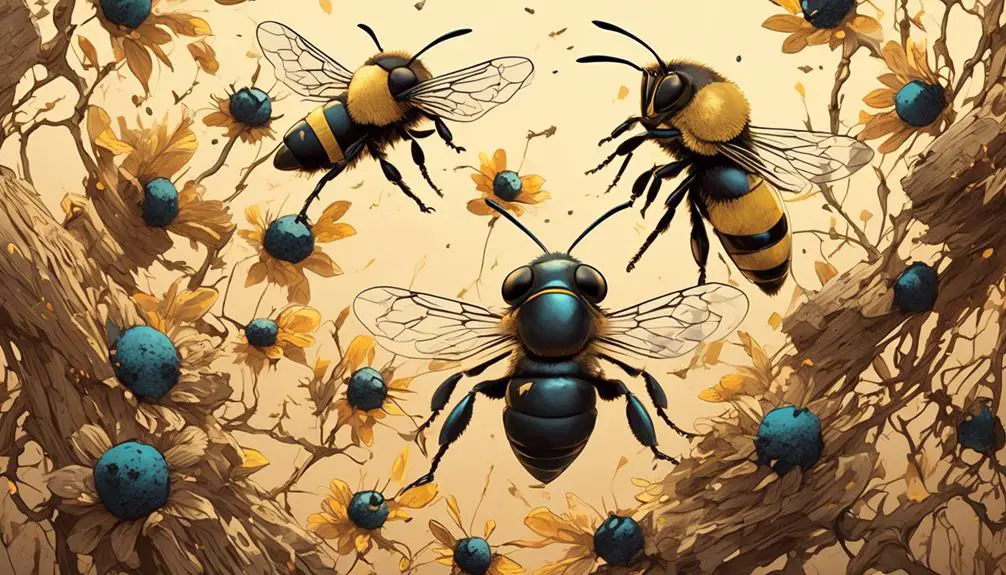
Carpenter Bees Vs Mud Daubers
As you dust off your trusty old monocle, you might notice a curious buzz in your backyard. You're not alone in your intrigue. Many find themselves in a quandary trying to distinguish between the Carpenter Bee and the Mud Dauber. These two insects, while differing significantly in their behaviors and impact on your surroundings, share certain resemblances that often lead to confusion.
Let's debunk some myths, shall we? Whether you're a professional entomologist or just a curious observer, we're about to journey into the fascinating world of these two species. And who knows, you might just find a newfound respect for these little creatures, or at the very least, learn how to manage an unexpected infestation.
Key Takeaways
- Carpenter bees and mud daubers have distinct physical characteristics and nesting habits.
- Carpenter bees bore into wood to create nests, while mud daubers construct nests using mud.
- Carpenter bees are important pollinators, while mud daubers help control spider populations.
- Effective management of infestations includes accurate identification and implementing preventive measures.
Identifying Carpenter Bees
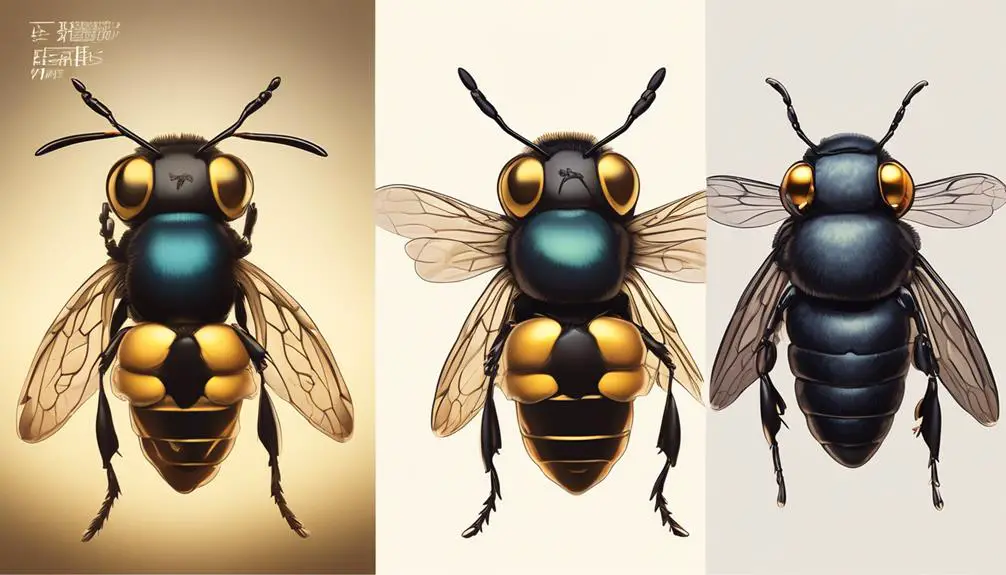
Understanding the carpenter bee's distinct characteristics can significantly aid in their identification. These large, robust insects often display a shiny, black abdomen and have a fondness for burrowing into wood. You'll notice that unlike other bees, their abdomens are mostly devoid of hairs, giving them a polished, metallic look. Their size, ranging from 1/2 to 1 inch, and the round entrance holes they create in wood, are other telltale signs of their presence.
Though they're fairly solitary insects, you might encounter males hovering around nests, conducting their diligent guard duty. Don't fret too much about them; male carpenter bees can't sting. Females can, but they're usually docile unless provoked. It's important to remember that they're not just pests; they're also significant pollinators, especially for open-faced flowers.
However, they can become a significant nuisance if they've chosen your home as their nesting site. Their tunneling can cause serious structural damage over time. If you've spotted any of these signs, you're likely dealing with a carpenter bee infestation. It's essential to take action quickly, assessing the extent of the damage and exploring control options.
Understanding Mud Daubers
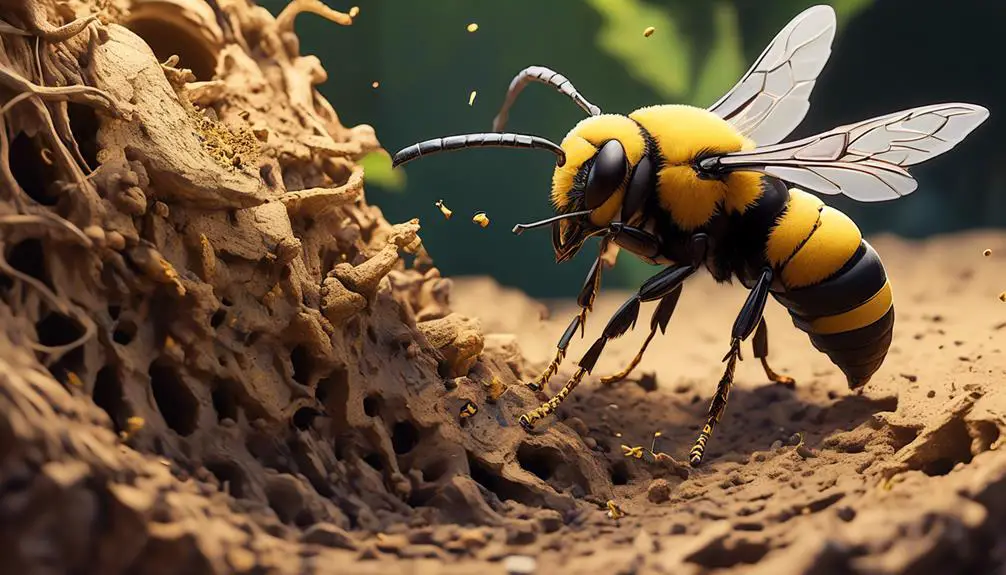
Now, let's turn our attention to mud daubers, a distinctive group of wasps known for their unique nest-building habits. Unlike their more aggressive counterparts, mud daubers are solitary wasps. You'll often see them constructing nests out of mud, hence their namesake. They're more focused on building their homes and hunting spiders to feed their offspring than stinging you.
To understand mud daubers better, here's a brief comparison between them and carpenter bees:
Traits | Mud Daubers | Carpenter Bees |
|---|---|---|
Nesting | Mud nests | Wood tunnels |
Aggression | Less aggressive | More aggressive |
Social Structure | Solitary | Solitary |
Food | Spiders | Nectar and pollen |
Mud daubers are less aggressive but don't let this fool you into thinking they're harmless. If threatened or provoked, they will defend themselves. They're also less destructive than carpenter bees. While the latter drills holes into wood to nest, mud daubers simply use mud, leaving your wooden structures unharmed. However, their mud nests can be an eyesore and are often found in inconvenient locations. Now you know the basics, you're better equipped to deal with these wasps.
Differences in Nesting Habits
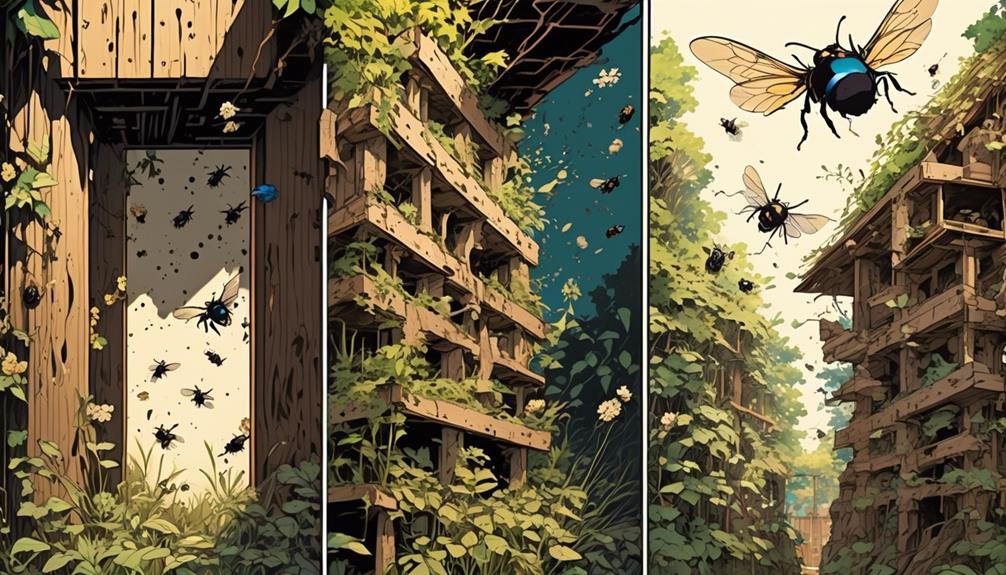
Diving deeper into their contrasting lifestyles, you'll find that the nesting habits of carpenter bees and mud daubers reveal fascinating aspects of their behavior and impact on their environment.
Carpenter bees, as their name implies, bore into wood to create their nests. They prefer weathered and untreated wood, creating round, smooth tunnels that may cause structural damage over time. Each tunnel houses a single larva, with a supply of pollen and nectar for nourishment.
On the other hand, mud daubers construct their nests using mud, as their name suggests. They build small, cylindrical mud tubes, often under eaves or in other sheltered areas. Remarkably, each tube is filled with paralyzed spiders, serving as a food source for their offspring. Unlike carpenter bees, mud daubers' nesting habits don't generally cause structural damage, but their nests can be an unsightly nuisance.
In essence, these differences in nesting habits reflect the adaptation of both species to their environment and the resources available. It's interesting how their lifestyles diverge, yet both species ensure the survival of their next generation in their unique ways.
Impact on the Ecosystem

Beyond their distinctive nesting habits, the roles that carpenter bees and mud daubers play in the ecosystem are quite significant and diverse. They both contribute to the balance of nature in unique ways.
As pollinators, carpenter bees play a vital role. They transfer pollen from the male parts of a flower to the female parts, aiding in fertilization and the growth of new plants. You'll often see these bees buzzing around, their bodies dusted with pollen.
Mud daubers, on the other hand, help control the population of other insects, particularly spiders. They paralyze spiders with their sting and carry them off to their mud nests as food for their larvae. You needn't worry about a spider infestation when these daubers are around!
Here's a concise table that compares their roles:
Insect | Role | Impact |
|---|---|---|
Carpenter Bees | Pollinators | Aid in plant growth |
Mud Daubers | Predator | Control spider population |
Managing an Infestation
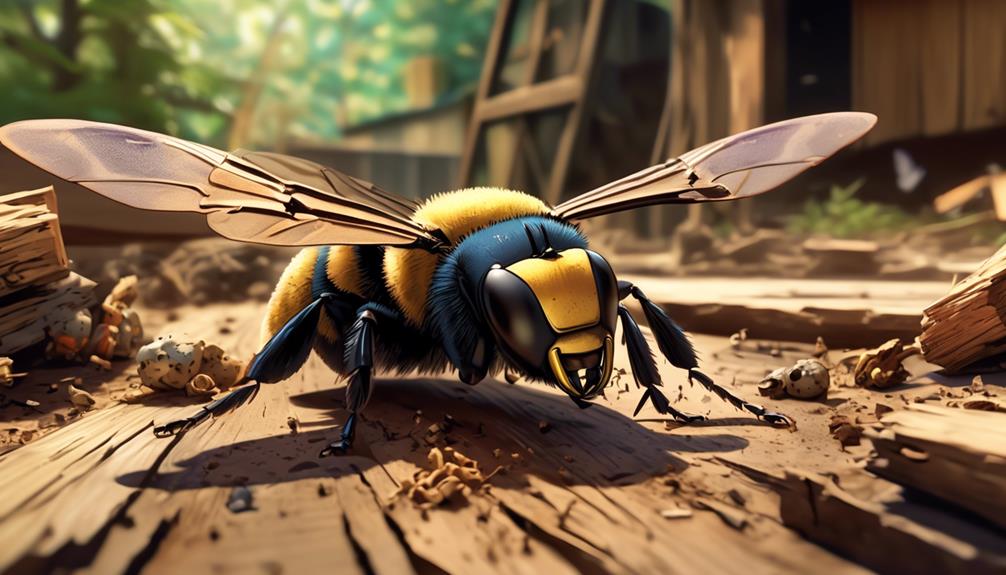
While appreciating the important roles that carpenter bees and mud daubers play in our ecosystem, it's also crucial to know how to effectively manage any potential infestations to maintain a harmonious coexistence. Effective management starts with accurate identification.
You must identify whether it's a carpenter bee or a mud dauber infestation. Carpenter bees bore into wood to build nests, leaving behind perfect round holes, while mud daubers construct mud nests on flat surfaces.
If it's a carpenter bee you're dealing with, then you'll want to use insecticidal dust in the holes they've bored. For mud daubers, it's best to remove their mud nests. But remember, this should be done at night when they're less active to reduce the risk of getting stung.
Invest in preventive measures too. Carpenter bees dislike painted or treated wood. So, keep your wood surfaces painted or varnished. For mud daubers, sealing cracks and crevices in the building can help prevent them from building nests.
Conclusion
In sum, you've got carpenter bees, power drillers of wood, and mud daubers, sculptors of clay. Each has unique nesting habits and roles in our ecosystem.
Their presence can be beneficial, but an infestation is a different story. Knowing the difference is key. Remember, managing an infestation can be tricky, so don't hesitate to call a professional if you're in over your head.
Nature's balance is delicate; let's respect it while protecting our homes.


